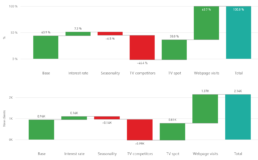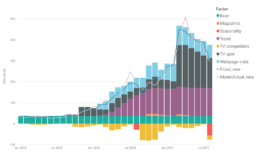Econometrics as a solution to blind spots in your marketing strategy: Grizzlink introduces econometric analysis.
You have the efficiency of your digital channels sorted thanks to ROI or ROAS, but can’t evaluate the impact of other channels offline? And how to analyse situations where the customers decide to buy your product based on your TV and through Google Ads only finishes the purchase? Based on the ROI in Google Analytics, the impactful channel is Google Ads and TV remains attributeless. Had it not been for it, though, the purchase would’ve never happened. How to approach this?
Grizzlink introduces a product among its analytical services which resolves all these pickles and helps brands make more informed strategic decisions: an econometric analysis.
Up until now, econometrics was mainly the domain of large corporations with deep pockets. Grizzlink strives to level the uneven playing field between David and Goliath and brings this tool not only to large media spenders but also to medium-sized companies whose strategic decisions have been clouded by intelligence blind spots. As with anything in marketing, the econometric analysis should be perceived as an investment, not an expense. Investment improves strategic decision making and strengthens your competitiveness in the long term.
Econometrics?
Econometrics is a field that explains economic relations through the use of economics, mathematics and statistics. It works with datasets worth of historical data, independent and dependent variables. The independent variables include media mix impressions (both you and your competitors), macroeconomic indicators, and other relevant factors; all on the weekly basis. The dependent variable is then business results – most frequently sales, but also a number of leads, store visits etc. To put it simply – the fundamental outcomes of an econometric analysis are the interpretation of the past, streamlining the present and predicting the future. Too ambitious? Read further.
1. Interpretation of the past
Thanks to the analysis of historical activities, we can evaluate which individual channel had the most impact on sales. Without thorough econometric analysis, it is virtually impossible to determine which channels are impactful and to what extent. At the same time, we can detect which channels are simply dead weight ready to be cut out off the media mix. The essential difference between an econometric analysis and an advanced attribution model is that the former does not examine a path to purchase of an individual customer, but works with the whole customer base.
What’s more, we don’t have to limit ourselves to media mix, but we can analyse other factors such as a creative, economic situation or cultural trends. This brings us to the next use of econometric analysis: making the present more effective.
2. More effective present
People best learn from their own mistakes, right? These don’t necessarily have to be mistakes. You could do all the planning by the book but thanks to econometrics you still find out that there is a slightly better split of media for your specific target segment. This way, econometric analysis can save up to 20% of your planned budget and redistribute it for improved effectiveness. Thanks to econometrics the next term will be planned based on real data specific to your segment and your brand. You don’t have to rely on assumptions or best practices for planning anymore.
3. Predicting the future
Thanks to econometrics, you can also predict your key performance indicators based on a specific media mix. Find out what the impact will be if you reallocate 10 % of your media spend to TV campaigns. What the consequences of halting your consumer contests will be. Simultaneously, you will be able to predict the impact of forces outside of your influence which still can have an impact on your business, such as macroeconomic indicators, cultural trends or the impact of weather.
It is noteworthy, however, that all these predictions must be based on historical activities. Although you can foretell the sales volume if you reallocate 10 % of your budget from one channel to another, you cannot predict the impact of adding a new channel, which you haven’t used before.
Case study
Analysis description
- The following case study is an analysis of an anonymous brand within the financial sector. We examine two financial products separately, but also within their mutual relationship across three and a half years with weekly data.
- The goal of the analysis was to determine the factors influencing the acquisition of new clients and to define future managerial recommendations.
- Entry data
- No. of new clients
- Media mix, both the brand’s and its competitors’
- Interest rates, own and the market’s average
- Webpage visits
- Seasonal factors
Main insights
- Media effectiveness: the crucial factors for Product 1 sales are TV campaigns and web visits. As for Product 2, besides TV and web, print ads also contribute to sales.
- Customer journey: TV serves as the first point of contact, builds brand awareness and influences website visits.
- Selection of media: the recommended approach for TV campaigns is to invest GRP between 200-250 for Product 1, and between 400-450 for Product 2.
- ROPO Effect: 1 out of 4 customers looks up Product 1 online, but purchases offline. For Product 2, on the other hand, ¾ of new customers search online and finish purchases in the branch office.
- Spillover effect: the TV campaigns for Product 1 have a positive influence on the number of new customers for Product 2.
- Base line (acquisition of new customers irrespective of marketing activities): Product 2 sees an increasing baseline thanks to long-term TV campaigns. Despite the basic hypothesis, this trend is not apparent for Product 1.
- TV campaigns contribute to webpage visits in 38 % of all cases. Webpage visits contribute to the acquisition of new clients in 63,7 % of cases.
- Carry-over effect (the impact of ads in one month on the customer behaviour in the following month) is at 20 %.
- Optimal Gross Rating Point is between 200 and 250 GRP.
- Increase in the baseline due to TV campaigns has not been detected yet despite the hypothesis built on the strength of TV campaigns.
- Webpage visits contribute to the ROPO effect (searching online, buying offline) in 28,4 % of cases.

- Only competitors’ TV campaigns have a negative influence on the acquisition of new clients.
- Competitors’ communication takes up 46,4 % of potential new clients.

- The number of new clients is affected by TV campaigns, website visits and print ads.
- The TV campaigns for Product 1 have a positive effect on the number of new clients for Product 2 (+67 new clients = 1,5 %).
- Long-term campaigns affect the increasing baseline.
- Long carry-over effect for Product 2 enables longer periods between campaigns (2-3 weeks).
- Ideal Gross Rating Points is between 400 and 450 GRP.
- ROPO Effect is at 78 % – approximately 3 out of 4 new customers search for information online and purchase in the branch store.

- TV campaigns contribute to webpage visits in 38 % of all cases. Webpage visits contribute to the acquisition of new clients in 63,7 % of cases.
- Carry-over effect (the impact of ads in one month on the customer behaviour in the following month) is at 20 %.
- Optimal Gross Rating Point is between 200 and 250 GRP.
- Increase in the baseline due to TV campaigns has not been detected yet despite the hypothesis built on the strength of TV campaigns.
- Webpage visits contribute to the ROPO effect (searching online, buying offline) in 28,4 % of cases.

- Only competitors’ TV campaigns have a negative influence on the acquisition of new clients.
- Competitors’ communication takes up 46,4 % of potential new clients.

- The number of new clients is affected by TV campaigns, website visits and print ads.
- The TV campaigns for Product 1 have a positive effect on the number of new clients for Product 2 (+67 new clients = 1,5 %).
- Long-term campaigns affect the increasing baseline.
- Long carry-over effect for Product 2 enables longer periods between campaigns (2-3 weeks).
- Ideal Gross Rating Points is between 400 and 450 GRP.
- ROPO Effect is at 78 % – approximately 3 out of 4 new customers search for information online and purchase in the branch store.



